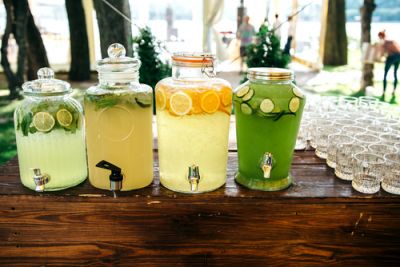 Besides food and entertainment, alcohol is often a major component of many wedding receptions. With the price of drinks as well as the labor involved in serving them, it’s no wonder that curating beverage options can be a major source of planning-related stress. However, you needn’t lose sleep figuring out how to provide and pay for enough drinks for a small crowd. A few useful strategies can help you pull off an excellent bar selection for your wedding guests.
Besides food and entertainment, alcohol is often a major component of many wedding receptions. With the price of drinks as well as the labor involved in serving them, it’s no wonder that curating beverage options can be a major source of planning-related stress. However, you needn’t lose sleep figuring out how to provide and pay for enough drinks for a small crowd. A few useful strategies can help you pull off an excellent bar selection for your wedding guests.
Consider Your Total Wedding Budget
Thanks to the wide range of drink options, it can be hard to ascertain your alcohol costs or how much of your wedding budget they should comprise. According to Wedding Wire expert Kim Forrest, reception expenses usually make up about 50 percent of the total budget, but that also includes food, décor, and entertainment.
Blogging for the popular wedding registry website Zola, Audra Jones reveals that a couple hosting an event with 200 guests can expect to spend an average of $8,000 for a fully stocked open bar. Even with the overall tab for a celebration that size ranging between $20,000 and $35,000, that’s still a huge chunk of change. On the other hand, a couple’s total wedding budget may fall far less than $8,000. If you’re trimming down total expenses to $10,000 or less, as shown in some examples from A Practical Wedding’s Alyssa Griffith, you’ll need to adopt an even more frugal approach to your drink offerings.
Estimating Your Alcohol Needs
There’s plenty of advice on how to determine how much alcohol you’ll need along with the amount you should expect to pay. According to most experts, you should expect each guest to consume an average of one drink per hour. Woman Getting Married offers a simplified guide with recommended breakdowns of what to buy for an open bar based on your anticipated guest count. The article’s figures assume that your bar will be open for around five hours. The guide also provides estimates based on half of your guests wanting wine while one-quarter of them drink beer and the remaining quarter choose liquor.
Meanwhile, Dana Eastland of A Practical Wedding provides suggestions for stocking a modified full bar along with a setup with beer and wine only based on 100 guests and six hours of service. She also points out that a DIY or self-serve bar may lead to larger servings per guest and can burn through your drink supply quicker. Finally, she advises readers to adjust their ratios of wine, liquor, and beer based on their crowds’ preferences.
Cost-Cutting Strategies to Consider
In her Zola blog post, Jones offers sage advice for trimming your reception’s alcohol expenses. Taking advantage of the signature cocktail trend is one wise strategy to control the cost of ingredients while satisfying your friends and family. To give your guests even more options, make sure that each of the cocktails you offer has a distinctive flavor profile. The Knot lists several suggestions for easy and affordable “big batch” cocktails. At the same time, Jones proposes a few other methods to keep costs down:
- Offering only wine and beer
- Forgoing a champagne toast
- Instructing servers to fill toasting glasses only halfway
- Leaving one bottle of wine at each table
- Limiting the available hours of your open bar
- Restricting liquor consumption to cocktail hour
- Insisting that your caterer charge per head
- Avoiding expensive spirits
- Hosting your wedding during daytime hours
Hospitality, Flavor, and Flair
Any aspect of wedding planning can be stressful, but some may encounter difficulty when trying to determine their reception’s alcohol requirements. Achieving the right mix and keeping costs reasonable can be tricky, but it’s not impossible. By using tried-and-true principles with some unique hacks, you’ll offer a budget-friendly beverage menu that your guests will love.
Add Your Comment